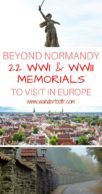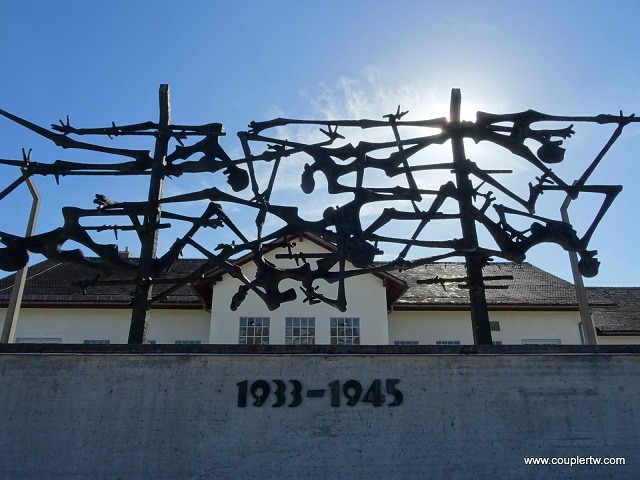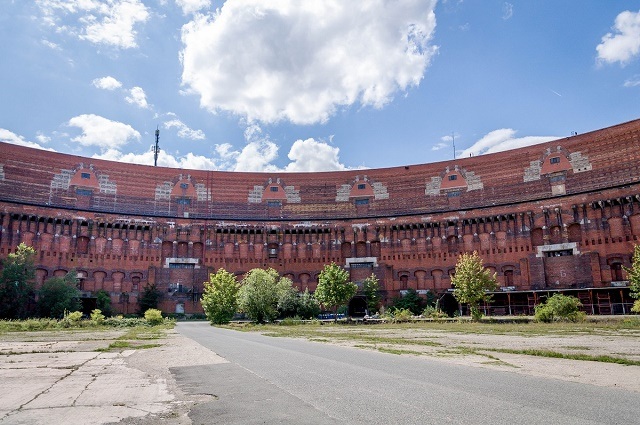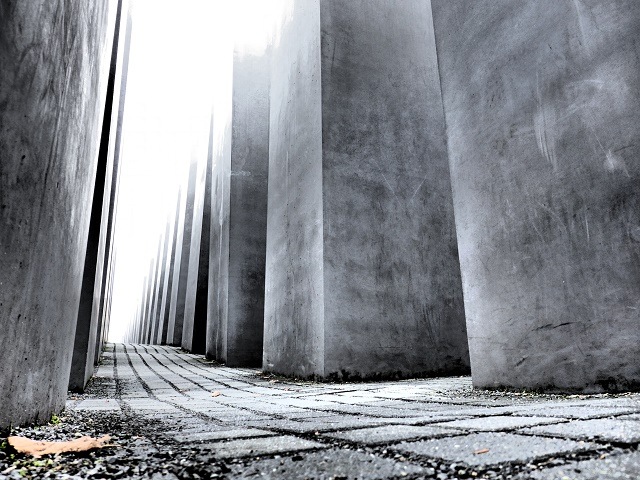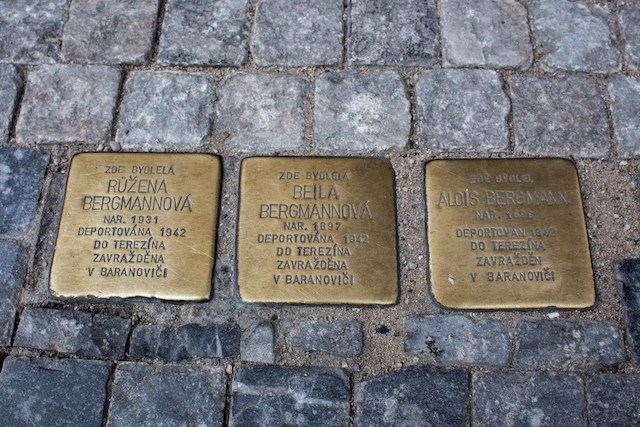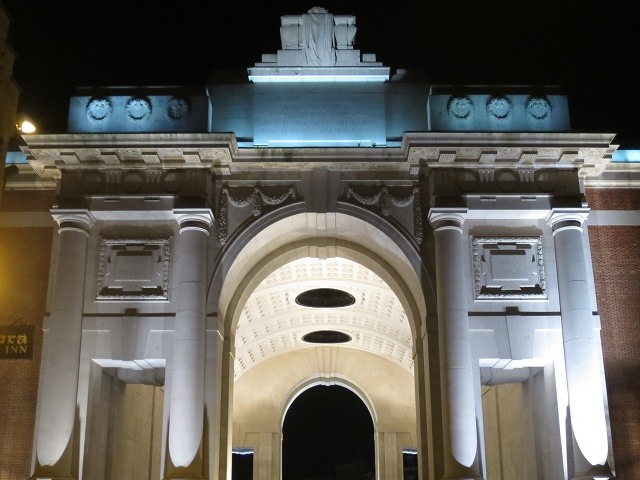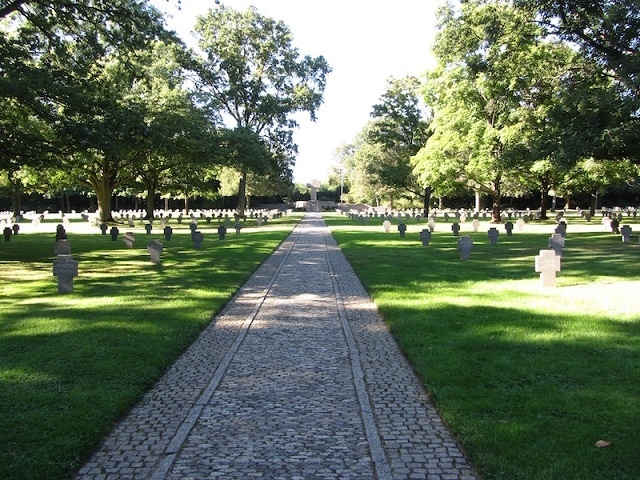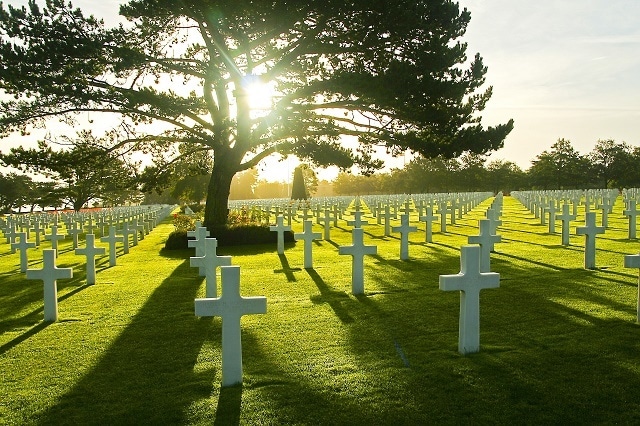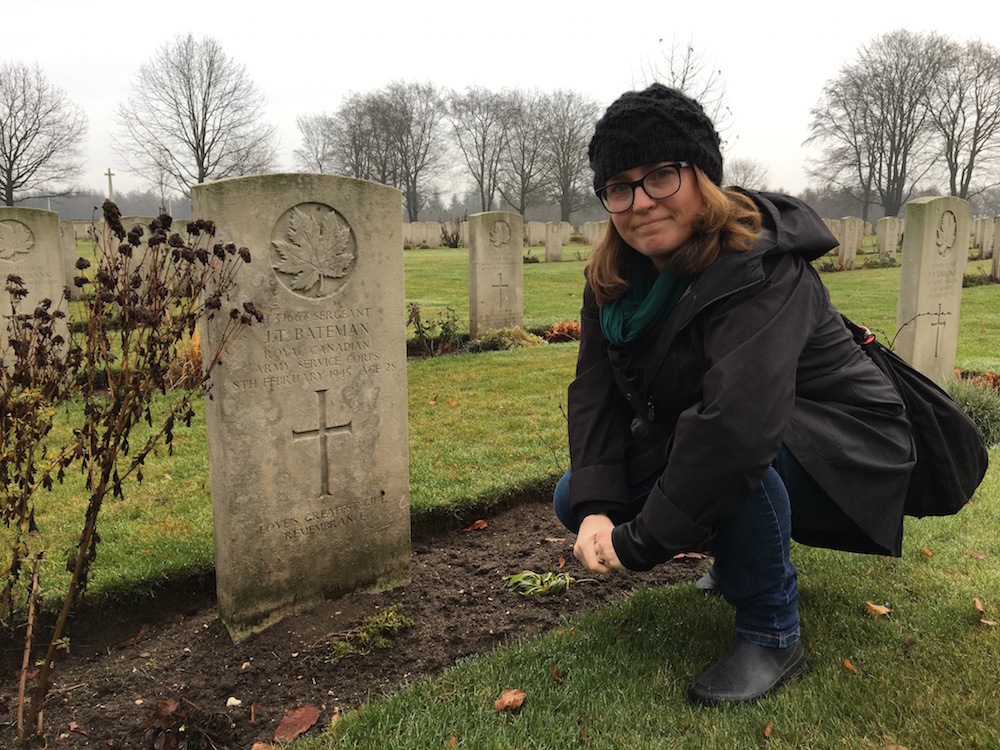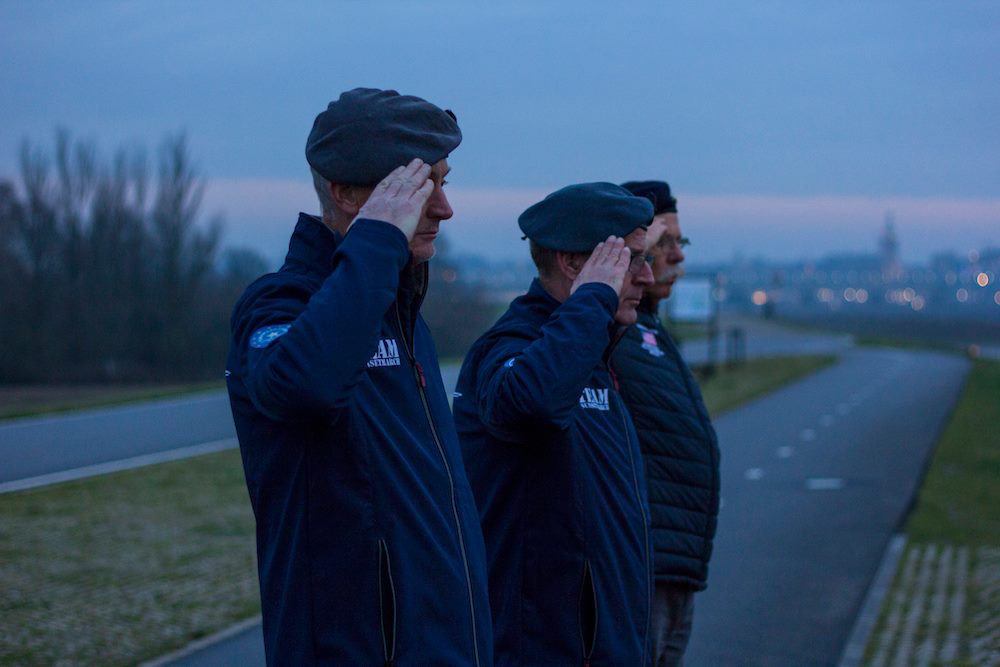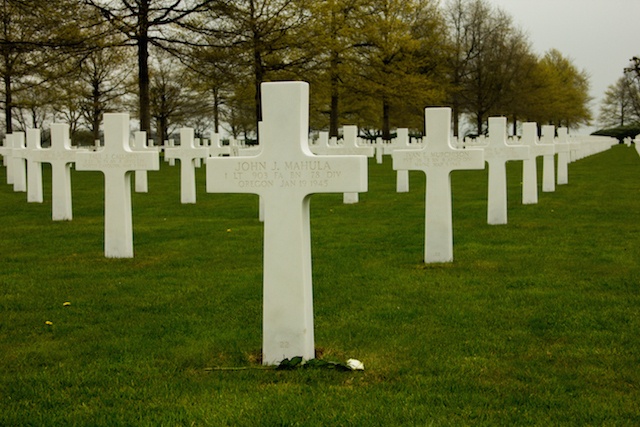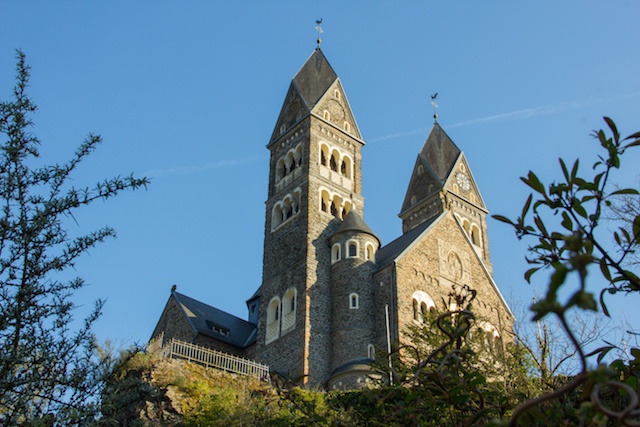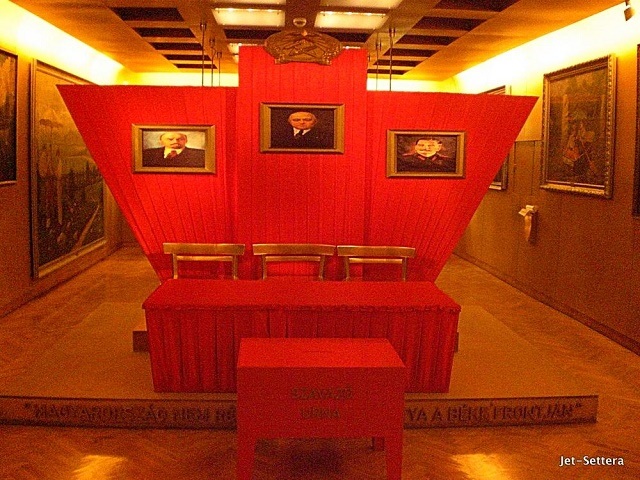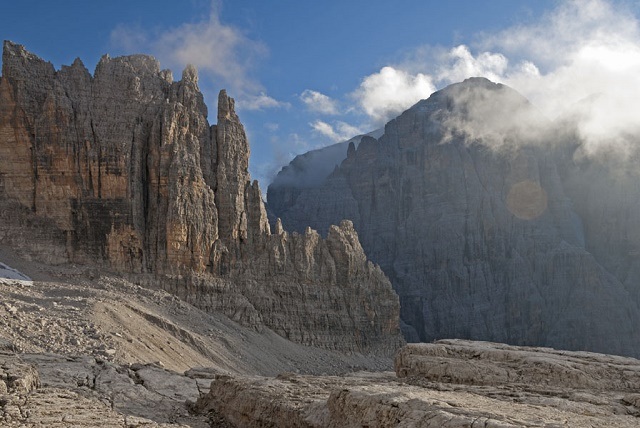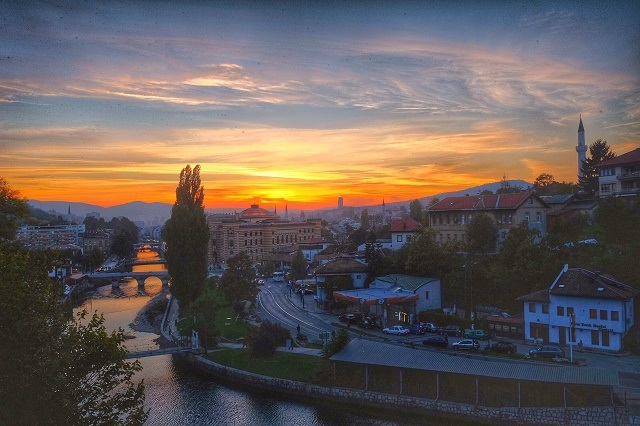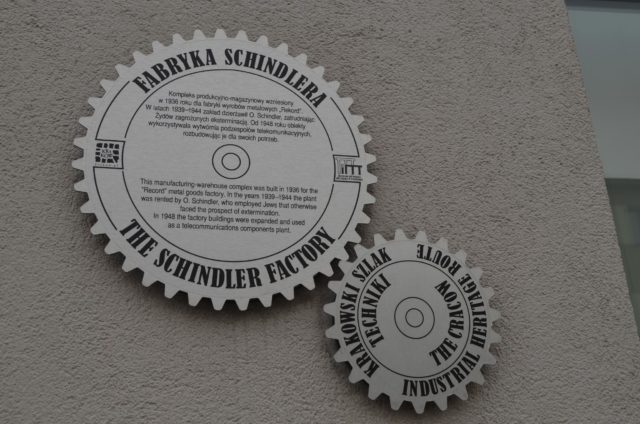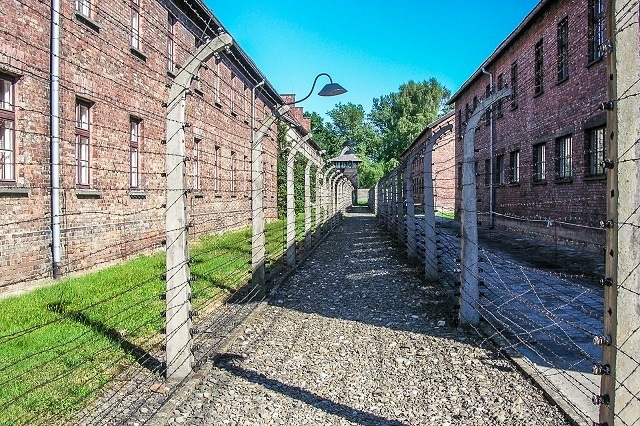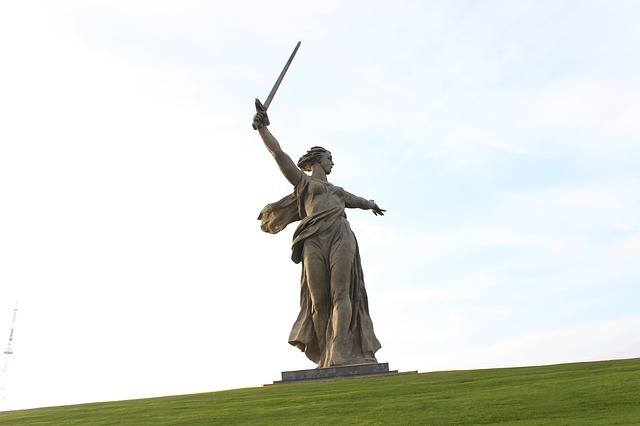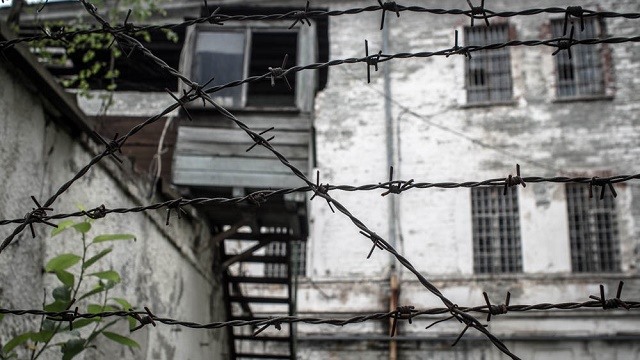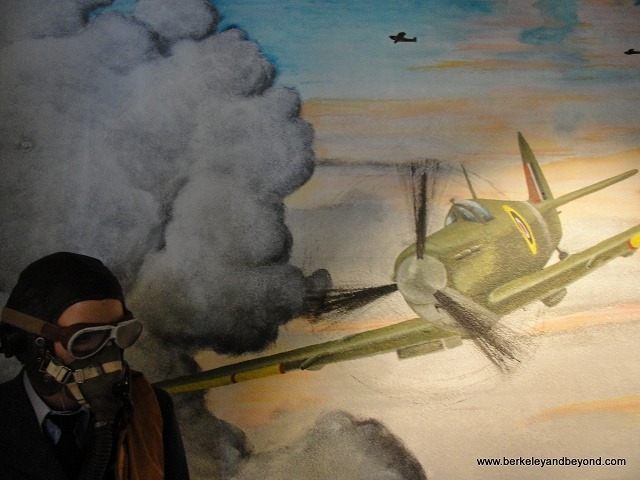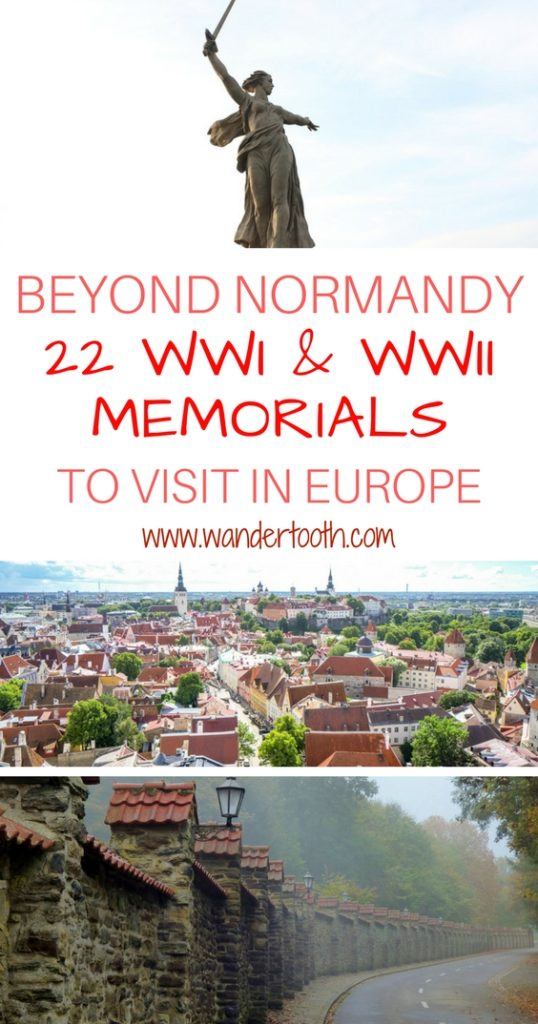Beyond Normandy: 11 Travel Bloggers Share 22 WWI & WWII Remembrance Tourism Destinations to Visit in Europe (& Beyond)
Disclosure: This website contains affiliate links. That means we earn a commission when you use the links on this site to book a hotel, buy your travel insurance, etc.. You don’t pay anything extra, and it helps us cover our costs. If you’d like to learn more about how this works, you can read more under our Disclaimer page. Some of the bloggers included in this post may have received compensation while visiting these locations, and we have travelled to several locations listed in partnership with Liberation Route Europe.
Lately, you may have noticed, we’ve been doing a lot of remembrance-themed trips.
After seeing the WWI grave of Geoff’s great-great uncle near Ypres, Belgium a few years back — and getting so excited by it, we then immediately changed our travel plans to go see my great-uncle’s WWII grave in Normandy — we realized Remembrance tourism is a theme we’re both interested in.
Since then, we’ve done different types of trips, most recently a Battle of the Bulge trip that included riding around Belgium in an American military jeep from WWII. Both of us feel like remembrance tourism is important, and our generation has a duty to remember what happened when the world went to war.
With that in mind, we thought we’d reach out and ask some of our travel blogging peers about their experiences with remembrance tourism, too. And what they came up with is essentially a bucket list for battlefield and remembrance tourism in Europe.
Of course, this isn’t a comprehensive list, but rather descriptions of the places the writers felt had the most impact on them. We hope you enjoy!
Remembrance Sites in Germany:
- Sachsanhausen
- Dachau Concentration Camp
- Nazi Party Rally Grounds
- Memorial to the Murdered Jews of Europe
- The Jewish Museum in Berlin
- Stumbling Stones
Remembrance Sites in Benelux & France:
- Ieper/Ypres, Belgium
- Luxembourg American Cemetery
- Normandy
- Groesbeek Canadian War Cemetery
- The Sunset March in Nijmegen, Netherlands
- Netherlands American Cemetery
- Clervaux, Luxembourg
Remembrance Sites in Central Europe & Balkans:
Remembrance Sites in Poland:
Remembrance Sites in Eastern Europe:
Off-the-Beaten-Path Remembrance Sites:
Remembrance Tourism in Germany
Sachsenhausen
Tamason of Travelling Book Junkie explains why visiting Sachsenhausen is such a strong experience
Before visiting Berlin, I had never heard of Sachsenhausen, a site that served as both a WWII concentration camp and a Soviet prison camp. Sitting on the outskirts of Oranienburg, just a short train ride from Berlin, it’s a place where prisoners were subjected to horrendous treatment. Today, when you wander around, you can still see where people lived, worked and died.
As soon as you walk through the gates there is an eerie feeling as vistors wander around in silence, trying to understand the extreme barbaric acts that took place here. Starved, worked to death or executed, this was a place where few people survived, and for me still remains the most emotional place I have ever visited.
Living today, it all seems like an abhorrent and fictional horror story rather than a story of truths. Every time I think about how those poor prisoners were tortured and executed, I feel rather disgusted by the human race. I just can’t imagine how one person can inflict that much pain on another, on such a large scale.
Living today, it all seems like an abhorrent and fictional horror story rather than a story of truths. Every time I think about how those poor prisoners were tortured and executed, I feel rather disgusted by the human race. I just can’t imagine how one person can inflict that much pain on another, on such a large scale.
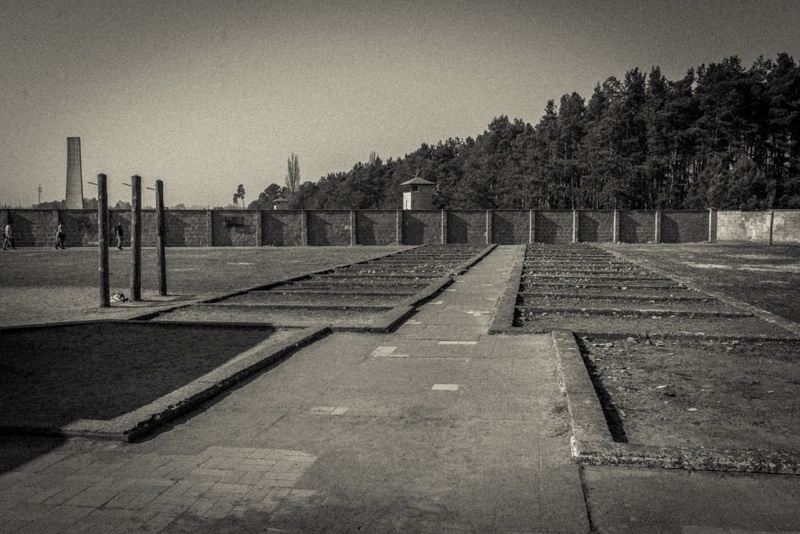
Dachau Concentration Camp Memorial
The bloggers behind Couple Round The World tell you why you should visit Dachau Concentration Camp
Visiting Dachau Concentration Camp Memorial is a journey back in time, a cultural experience, and a history lesson, all in one. Dachau wasn’t the biggest concentration camp, nor was it considered the worst. It was, however, the first, and was used as a model from which all the others were created, making if relevant to a big picture view of WWII history, as well as individual stories. During a visit to Dachau, you can learn more about this, the Kapo system, the internal hierarchy and the liberation of the camp. Nowadays, you can visit Dachau for free, or take a guided tour for only 3 Euros, and learn more about the site and what happened there.
Most of the time, traveling is about fun, beautiful scenery, cultural experiences and amazing adventures. But it is also a way of getting to know other people better and understand our humanity… the good, the bad, and the astonishing evil.
© Couple RTW. Used with permission.
The Nazi Party Rally Grounds
Lance & Laura of Travel Addicts explain why the Nazi Party Rally Grounds in Nuremberg are worth visiting, even if you’re not a history buff.
Before the atrocities of the Nazi regime became apparent to the world, it was a political organization that went under the benign name of The National Socialist German Workers’ Party. That’s right – the group would bring about total devastation to millions of people and scar three continents began as a political party – a big one, at that.
Every summer, the Nazi faithful would gather in Nuremberg, Germany at an elaborate complex to stage rallies and whip themselves into a frenzy, which would soon turn to madness.
While many World War II-era sites, specifically sites relating to the Nazi regime, were completely destroyed, the Nazi Party Rally Grounds in Nuremberg are almost completely intact. You can play football on the fields where the Nazis marched…and stand on the same pedestal where Hitler used to address the masses.
In an era of xenophobia and mass populism, it’s important to see what a twisted mind can conjure…and Nuremberg provides a perfect place to do so.
© Travel Addicts. Used with permission.
The Memorial to the Murdered Jews of Europe
Rachel of Rachel’s Ruminations shows why a visit to The Memorial to the Murdered Jews of Europe is both touching and frustrating
The Memorial to the Murdered Jews of Europe did not affect me in the way I assume it was intended to. Rather than serving as a place to reflect on and mourn the Holocaust that killed so many of my people, the Memorial was being used as a playground, a meeting place, and as a backdrop for selfies. I was appalled. What makes it worse is that this memorial is in Berlin, the capital of the regime that made the Holocaust happen.
Recently a German-Israeli named Shahak Shapira went viral with his “Yolocaust” project. Finding pictures online of selfies taken at the Memorial to the Murdered Jews of Europe, he photoshopped the people into historical Holocaust photos. By posting the resulting shots online, he shamed the people involved into apologizing.
Will Yolocaust cause future visitors to take the memorial more seriously? I hope so. Then it could serve the purpose that is evidently so sorely needed in Berlin: creating some sense of respect and honor for those who died in the Holocaust.
© Rachel’s Ruminations. Used with permission.
The Jewish Museum in Berlin
Inma of A World To Travel explains why The Jewish Museum should be added to your Berlin itinerary
The Jewish Museum in Berlin is a place to reflect on and learn about the repercussions of the Holocaust, as well as the social, cultural and political history of the Jewish community in Germany from the 4th century until today.
It is also a place to feel architecture like no other. From its ‘between the lines’ façades, to unique halls like the ‘Memory Void’ with the installation Schalechet (Fallen Leaves), by M. Kadishman, the visit will leave you speechless.
Do not leave Berlin without exploring it — you have been warned!
© A World to Travel. Used with permission.
Stumbling Stones
Our favorite tributes to individual victims of the Holocaust are ‘stolpersteine,’ or stumbling stones, which began in Berlin but can now be found in 22 European countries.
Keep your eyes cast downward in many European cities, and you’re sure to see one of the more than 56,000 stolpersteine replacing cobbles in the sidewalks. Beginning as a project by Berlin artist Gunter Demnig, the stolpersteine are laid in front of the victims’ last residences, and include details in the local language about their life and, often, their death.
Whenever we see stolpersteine, we try to stop and pay a small moment of remembrance.
Remembrance Tourism in Benelux and France
Ieper/Ypres, Belgium
Kerri McConnel of Beer and Croissants explains why Ieper is a must-visit on any trip to Belgium
“They shall grow not old, as we that are left grow old;
Age shall not weary them, nor the years condemn.
At the going down of the sun and in the morning
We will remember them.”*
This poem, The Ode, is ingrained indelibly in my brain. Each year on ANZAC Day in Australia, The Ode is read. Throughout the year, on various important military occasions, The Ode and the playing of the Last Post is what sends shivers up and down our spines. It’s a reminder of the freedoms that we enjoy in many countries today.
Visiting Ieper, in Belgium’s west, and attending the Last Post ceremony, is something I will never forget.
Underneath the Menin Gate, the Last Post ceremony is conducted every night, and has been done so since 1928. Thousands of visitors flock here to witness this significant event, honouring the Allies who fought and were killed in the fields during World War I. It is believed to be the only daily ceremony of its kind in the world.
Most poignant is the inclusion every day of family members, associations and friends connected to those who fought and lost their lives in these battles. They come to lay wreaths and to remember their loved ones who fought and lost.
I have visited many war fields and museums throughout the world, but none felt more personal than this. It was another important reminder of the futility of war, with entire generations being lost unnecessarily.
*The Ode by Laurence Binyon, as published in the Winnowing Fan: Poems of the Great War, 1914
© Beer and Croissants. Used with permission.
Luxembourg American Cemetery & Memorial / Sandweiler German Military Cemetery
Brianne Miers of A Traveling Life explains why the Luxembourg American Cemetery & Memorial and Sandweiler German Military Cemetery are important memories of the conflict
Not far from the Luxembourg Airport are the graves of more than 15,000 American and German soldiers. While these mostly young men met their end the same way – killed in action during World War II – their final resting places are quite different.
The Luxembourg American Cemetery and Memorial is managed by the U.S. government, and comprised of a perfectly manicured 17-acre lawn dotted with 5,076 white marble markers. It features an elaborate chapel, complete with a mosaic ceiling and a monument dedicated to the hundreds missing in action. About a mile down a winding road is the more subdued Sandweiler German Military Cemetery, where simple stone crosses cover a much smaller, less pristine lawn. The 10,913 dead here are named four to a cross, and there is a mass grave of unknowns.
Both cemeteries, however, are important reminders of the enormous toll that World War II had on families and communities on all sides of the conflict.
© A Traveling Life. Used with permission.
Normandy, France
Maria Haase of Europe Up Close explains why a visit to Normandy changes you forever
I grew up in Germany and now live in the US, and visiting World War II Memorials in other countries is always a very touching experience.
Ever since I watched Steven Spielberg’s Saving Private Ryan, I’ve wanted to see the beaches of D-Day for myself. If you are interested in history, Normandy is full of somber memorials that honor the soldiers who lost their lives on D-Day, as well as some excellent museums that will give you a better understanding of the historic events during this part of WWII.
Add to that, Normandy is such a beautiful place. The coast line switches from rugged cliffs to sandy beaches.
The wind and the lingering, foggy mist gives it a mystical feeling. Knowing so many people died here is humbling and touching. Just like the fog, it lingers on your mood. When you visit Normandy, it touches you, and you leave as a different person.
© Europe Up Close. Used with permission.
Groesbeek Canadian War Cemetery
It shouldn’t be the case, generations apart and people we’ve never met, but visiting the war graves of family somehow makes it all seem more real, more connected.
Left from the cemetery’s entrance gate, to the right, a few paces along a row of neatly kept graves. There lie my Great Uncle Johnny’s remains, the name of my paternal grandmother’s brother neatly etched under a maple leaf, hints of his life and death below.
37667 Sergeant J.T. Bateman
Royal Canadian Army Service Corps
8th February 1945 Age 28
Love’s greatest gift. Remembrance.
My grandmother died when I was young, and of course Johnny made his sacrifice long before my debut. It shouldn’t feel this visceral, and yet I find myself raising my hand to my face over and over again, staining my leather glove with salty tears.
Because there’s something different about visiting the war graves of family, something that makes you remember how real it was on a different level.
The Sunset March in Nijmegen, Netherlands
The Netherlands is a country that remembers what happened here in WWII, but the Sunset March is by far one of the most touching acts of remembrance.
Each and every day, rain, shine, sleet or snow, a group of veterans meet at the south end of the De Oversteek bridge. As the sun completes its task of setting for the evening, the veterans and anyone else who wishes to join them march across the bridge, at a military pace, to the coordinated lighting of the bridge.
This choreographed act of remembering isn’t by accident, and the lights on the bridge are symbolic, each one representing the 48 American soldiers that were killed during the Waal River Crossing, a key battle within Operation Market Garden toward the end of WWII.
Netherlands American Cemetery
After WWII, locals around the Dutch village of Margraten realized the American soldiers lying in the nearby cemetery wouldn’t have friends and family to take on the everyday acts of caring for their loved ones, and so they took it upon themselves to do so.
Now passed from generation-to-generations, locals have adopted the soldiers at this cemetery, taking over the small, everyday acts of remembrance, such as visiting ‘their’ soldier’s grave, and laying flowers.
Europe is full of massive monuments to the war, but the small acts of individuals go a long way in keeping the memory alive, as well.
Clervaux, Luxembourg
Luxembourg is a tiny country that packs a huge punch when it comes to WWII tourism, and Clervaux is a great town to add to your itinerary.
No one really expected the small and picturesque town of Clervaux to play a strategic role in WWII, and yet it ended up being heavily fought over during the Battle of the Bulge, which took place in the Adrennes region of Luxembourg and Belgium. What I most liked about visiting Clervaux is how easy it was to imagine what happened here during the Battle of the Bulge: the geography is such that the town is tucked in a village, surrounded by forested hills on all sides. From the castle, you can see where the different troops were positioned, and imagine the sequence of events in vivid detail.
Luxembourg is underrated as a remembrance tourism destination; as one guide told us, “We have more war memorials than we have communes in Luxembourg.”
Remembrance Tourism in Central Europe & Balkans
The House of Terror in Budapest
Barbara Wagner of Jet-Settera shares her experience at The House of Terror in Budapest, Hungary
The House of Terror in Budapest (Andrassy ut 60) is a memorial museum to commemorate the victims who were killed and tortured by the Communists after WWII. The building was the headquarter of the former AVO (communist police). In the basement of the building, you can see the torture chamber they used to torture people who did not comply with the system. On the upper floors, you can see photos and objects of the communist era and learn about the Communist Party in Hungary after WWII.
There is a large tank in the lobby of the museum and the walls are wallpapered with the faces of the victims. The museum is interesting, and does a good job at portraying the Communist era in Hungary. I’d recommend it to anyone who wants to learn about Communist Hungary.
© Jet-Settera. Used with permission.
The Dolomites in Italy and Austria
Margheritta Ragg of The Crowded Planet shows us the history behind the snow-capped Dolomites Mountains
The Dolomites aren’t just a stunning mountain destination – they are a place where thousands of young men lost their lives just over 100 years ago. The bloody frontline between Italy and Austria used to run along the Dolomites mountains, and WWI was fought fiercely between snow, ice and winter gales. My own great-grandfather was one of the soldiers that spent years in mountain trenches, fighting daily to gain a few centimeters of land. There are literally hundreds of trenches and forts all around the Italian Alps, and sometimes when glaciers melt a lot in summer, you can still find bullets and grenades under the ice.
Strangely, WWI was also one of the reasons why the Dolomites became a popular tourist destination in Italy between the two wars. Soldiers fell in love with the mountain scenery, and decided to take their families there on holiday. Looking at these pictures, I can see why they liked the scenery so much. I hope it gave them comfort during their fight.
© The Crowded Planet. Used with permission.
Sarajevo, Bosnia-Herzegovina
Ian Ellis-Jones of Escaping Expectation explains why Sarajevo, the city where World War I started, is interesting for remembrance tourists.
It’s difficult to visit the Balkans and not be reminded of all the history and daunting events that have taken place in the region. And Sarajevo, the capital of Bosnia & Herzegovina, has unfortunately been stuck in the middle of it all. Visiting Sarajevo today is a humbling experience; automatic machine gun bullet holes still cover many buildings, you’ll walk by several museums dedicated to its difficult past, and locals still openly discuss “Sniper’s Alley,” where over 60 children were killed during the Bosnian War.
As you might recall from history class, Sarajevo was where Austria’s Archduke Franz Ferdinand was assassinated, which ultimately lead to the start of World War I.
As I walked across the Latin Bridge, the site of the assassination, I couldn’t help but think about the devastating consequences that resulted from what happened on the bridge that day – the bridge that I was standing on. And with the complex geopolitical environment that we live in today, amplified by uncertainty and fear, I couldn’t help but think of it as a stark, cautionary reminder that seemingly singular events can have catastrophic ramifications on the world stage.
© Escaping Expectation. Used with permission.
If you’re planning a remembrance trip to Europe that’s focused on WWII, be sure to check out Liberation Route Europe, a not-for-profit dedicated to creating an international remembrance trail that connects important sites along the Western Allies’ advance across Europe. Their website is quite helpful, as are the free apps they’ve created for travelers!
Remembrance Tourism in Poland
Schindler’s Factory
Hannah Logan of Eat Sleep Breathe Travel on why you need to visit the Schindler’s Factory when traveling to Krakow.
I remember the shock I felt walking through Schindler’s factory in Krakow, Poland. For so long it had just been a movie I watched during history class in school. But as I stood in the office of a man who could be described as both villain and hero, the reality that this story wasn’t just a Hollywood script hit home.
Today, Schindler’s factory is a war museum showcasing the realities of Krakow Poland under the Nazi regime during WWII. Photographs, documents, articles, and even personal possessions create a story of what it was like to live in the city from 1939-1945; the horrors, the fears, the terror. I spent hours walking in silence up and down the hallways; past weapons and uniforms, nazi propaganda, and horrifying quotes from children who watched their friends thrown from windows.
I left the museum brokenhearted and yet I was glad I went. A visit to this museum made the war so much more real than the facts in my history textbook. For anyone headed to Krakow, a visit to Schindler’s Factory is a must.
© Eat Sleep Breathe Travel. Used with permission.
Auschwitz Concentration Camp
Gabor of Surfing the Planet on the infamous Auschwitz Concentration Camp
There’s no doubt the Auschwitz Concentration Camp symbolizes the cruelty of the Third Reich. The Nazis built the largest prison complex ever near the small Polish town of Oświęcim. This huge complex included prisons, labor camps and, during the last years of the war, the extermination camps with gas chambers, where around three million people were executed with the efficiency of a machine. The concentration camp nowadays is a tourist destination that attracts more than a million remembrance visitors per year.
Auschwitz consists of two camps. Auschwitz I was the original concentration camp installed in army barracks. Here lies the infamous banner ‘ARBEIT MACHT FREI’, the ironic Nazi slogan saying ‘work sets you free’.
In some of these barracks, you can visit cells in their original state, whereas in others an exhibition tells you details of the horror. Although I knew the data from history class, it was still devastating to see the name of my country (Hungary) as first in the list that shows the number of people killed from each country. 430,000 people were deported, mostly from Budapest.
Not so far from Auschwitz I, you can visit the Auschwitz II-Birkenau camp, which was built in the last years of the war to keep up with the extermination program. Most of the camp was destroyed by the Nazis before the Allied armies liberated Poland.
© Surfing the Planet. Used with permission.
Remembrance Tourism in Eastern Europe
The Motherland Calls in Stalingrad (Volgograd), Russia
Yulia Dyukova of The Foodie Miles on Volgograd, Russia
One of the most significant battles of World War II happened between August 1942 and February 1943, when Nazi Germany fought the Soviet Union for control of Stalingrad (now Volgograd), Russia. It was the biggest defeat in the history of German army and a turning point in the war. Before Stalingrad, the German forces victoriously marched from country to country, moving deeper into USSR territory. After Stalingrad, they won no decisive battles. The battle is regarded as the bloodiest battle not only in WWII, but in the history of warfare, with close to 2 million wounded, killed and captured.
The colossal sculpture “The Motherland Calls” was erected on Mamaev Kurgan, the hill overlooking Volgograd (Stalingrad), to remember people who gave their lives to protect their families and country.
The monument looks incredibly dynamic, and consists of a woman – the allegorical image of Mother – walking with a sword in one hand, the other hand stretched out to call for her sons. Her face is stern and resolute, arms strong, and her dress and scarf fluttering in the wind.
The sculpture towers at 85 meters high. It is taller than Christ the Redeemer in Rio de Janeiro, and almost twice as tall as the Statue of Liberty (if measured without its pedestal). Interestingly, the monument is not fixed to its base plate, but is only supported by its own weight.
Photo (viaPixabay) by alex1983 is licensed under CC0 Public Domain. Resized from original.
Patarei Sea Fortress
Why should you add the Patarei Sea Fortress to your Estonia itinerary? Liam Alford of Rucksack Ramblings explains.
In Estonia’s capital city of Tallinn, you can find the chilling Patarei Sea Fortress. As the name suggests, it’s a four-story building located on the bank of the bleak Baltic Sea, resonating day and night with the pounding of the relentless waves. Used as a prison during both Nazi and Soviet times, the damp walls and crude atmosphere have caused thousands of prisoners to abandon any hope of returning to a decent life. Roaming through the corridors, you’ll stumble upon an absolutely terrifying surgery theatre, rusty bunk beds strewn with personal artifacts left behind, and even a hanging room, from which corpses were thrown over the cliffs to disappear into the black water.
Patarei or “the Battery” was the first in a long succession of WW2 memorials and museums we saw on our Eastern Europe trip. It’s still one of the most thought-provoking places we’ve ever been, brutally reminding us of how merciless the war was, and how many people were affected by it, from the death camps in Poland all the way up to Estonia in the North.
© Rucksack Ramblings. Used with permission.
Off-the-Beaten-Path Remembrance Tourism
Icelandic Wartime Museum
Carole Terwilliger Meyers of Travels With Carole shows why a trip to Iceland can incorporate remembrance tourism, too
I don’t recall ever hearing about Iceland in WWII, and was surprised to learn about its role at the Icelandic Wartime Museum (also known as the Icelandic World War II Museum) in the remote northeastern Iceland town of Reydarfjordur.
Positioned within a former freezing plant, the museum is reconstructed to resemble a hospital camp built here by Americans as an Allied base in response to Norway’s occupation by Germany. Artifacts are displayed and war stories told in a replica barrack and cinema hall, and some original barracks remain outside the museum. I was most surprised to learn the town had only 300 people when it was inundated during World War II with 4,000 soldiers from Britain, Canada, Norway, and the U.S.!
© Berkeley and Beyond. Used with permission.
Morocco
Amanda Ponzio-Mouttaki of Maroc Mama on Morocco’s role in the war
One of the forgotten battles of World War II is known as Operation Torch. In November of 1942, British and American troops invaded French North Africa with the goal of ridding this region of Axis forces and preparing to invade southern Europe. US General Eisenhower was given control of the operation and was based on the British-controlled island of Gibraltar.
In Morocco, the combined forces invaded in the cities of Safi, Fedala and Port Lyautey. The operation was successful and the allies were able to move inward relatively quickly. Today, visitors can visit the American Legation Museum in Tangier, which housed intelligence agents during WWII, or the famous Mamounia Hotel in Marrakech, where Churchill and FDR retreated after the Casablanca Conference.
While not a part of Europe, Morocco played and important role in the European theatre of war, and is reachable as a day trip or overnight trip from Spain.
© MarocMama. Used with permission.
Do you enjoy remembrance tourism in Europe? Which sites have we missed?
Planning a Remembrance Trip to Europe? Save This Post on Pinterest So You Never Lose It

